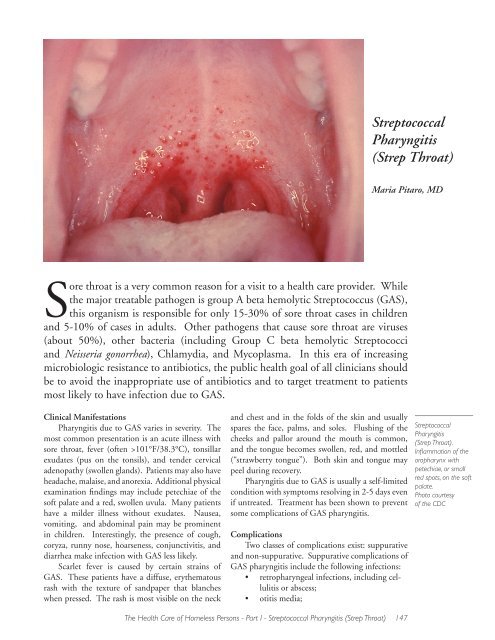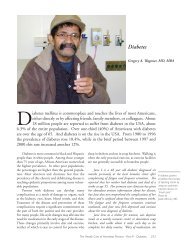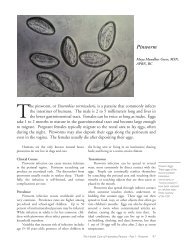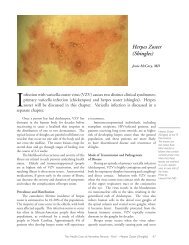Streptococcal Pharyngitis (Strep Throat) - Boston Health Care for the ...
Streptococcal Pharyngitis (Strep Throat) - Boston Health Care for the ...
Streptococcal Pharyngitis (Strep Throat) - Boston Health Care for the ...
You also want an ePaper? Increase the reach of your titles
YUMPU automatically turns print PDFs into web optimized ePapers that Google loves.
The <strong>Health</strong> <strong>Care</strong> of Homeless Persons - Part I - <strong><strong>Strep</strong>tococcal</strong> <strong>Pharyngitis</strong> (<strong>Strep</strong> <strong>Throat</strong>) 147<br />
<strong><strong>Strep</strong>tococcal</strong><br />
<strong>Pharyngitis</strong><br />
(<strong>Strep</strong> <strong>Throat</strong>)<br />
Maria Pitaro, MD<br />
Sore throat is a very common reason <strong>for</strong> a visit to a health care provider. While<br />
<strong>the</strong> major treatable pathogen is group A beta hemolytic <strong>Strep</strong>tococcus (GAS),<br />
this organism is responsible <strong>for</strong> only 15-30% of sore throat cases in children<br />
and 5-10% of cases in adults. O<strong>the</strong>r pathogens that cause sore throat are viruses<br />
(about 50%), o<strong>the</strong>r bacteria (including Group C beta hemolytic <strong>Strep</strong>tococci<br />
and Neisseria gonorrhea), Chlamydia, and Mycoplasma. In this era of increasing<br />
microbiologic resistance to antibiotics, <strong>the</strong> public health goal of all clinicians should<br />
be to avoid <strong>the</strong> inappropriate use of antibiotics and to target treatment to patients<br />
most likely to have infection due to GAS.<br />
Clinical Manifestations<br />
<strong>Pharyngitis</strong> due to GAS varies in severity. The<br />
most common presentation is an acute illness with<br />
sore throat, fever (often >101°F/38.3°C), tonsillar<br />
exudates (pus on <strong>the</strong> tonsils), and tender cervical<br />
adenopathy (swollen glands). Patients may also have<br />
headache, malaise, and anorexia. Additional physical<br />
examination findings may include petechiae of <strong>the</strong><br />
soft palate and a red, swollen uvula. Many patients<br />
have a milder illness without exudates. Nausea,<br />
vomiting, and abdominal pain may be prominent<br />
in children. Interestingly, <strong>the</strong> presence of cough,<br />
coryza, runny nose, hoarseness, conjunctivitis, and<br />
diarrhea make infection with GAS less likely.<br />
Scarlet fever is caused by certain strains of<br />
GAS. These patients have a diffuse, ery<strong>the</strong>matous<br />
rash with <strong>the</strong> texture of sandpaper that blanches<br />
when pressed. The rash is most visible on <strong>the</strong> neck<br />
and chest and in <strong>the</strong> folds of <strong>the</strong> skin and usually<br />
spares <strong>the</strong> face, palms, and soles. Flushing of <strong>the</strong><br />
cheeks and pallor around <strong>the</strong> mouth is common,<br />
and <strong>the</strong> tongue becomes swollen, red, and mottled<br />
(“strawberry tongue”). Both skin and tongue may<br />
peel during recovery.<br />
<strong>Pharyngitis</strong> due to GAS is usually a self-limited<br />
condition with symptoms resolving in 2-5 days even<br />
if untreated. Treatment has been shown to prevent<br />
some complications of GAS pharyngitis.<br />
Complications<br />
Two classes of complications exist: suppurative<br />
and non-suppurative. Suppurative complications of<br />
GAS pharyngitis include <strong>the</strong> following infections:<br />
• retropharyngeal infections, including cellulitis<br />
or abscess;<br />
• otitis media;<br />
<strong><strong>Strep</strong>tococcal</strong><br />
<strong>Pharyngitis</strong><br />
(<strong>Strep</strong> <strong>Throat</strong>).<br />
Inflammation of <strong>the</strong><br />
oropharynx with<br />
petechiae, or small<br />
red spots, on <strong>the</strong> soft<br />
palate.<br />
Photo courtesy<br />
of <strong>the</strong> CDC
• sinusitis; and<br />
• rare complications due to bacteremia, such<br />
as necrotizing fasciitis, meningitis, or brain<br />
abscess.<br />
Some studies have shown that antibiotic<br />
<strong>the</strong>rapy of GAS can decrease <strong>the</strong> incidence of otitis<br />
media and sinusitis.<br />
The most common non-suppurative complications<br />
are acute rheumatic fever and acute poststreptococcal<br />
glomerulonephritis. Acute rheumatic<br />
fever (ARF) is an inflammatory disease involving <strong>the</strong><br />
heart, joints, connective tissue, and nervous system.<br />
This usually arises within 2-4 weeks of pharyngitis<br />
and can result in progressive rheumatic heart disease.<br />
ARF happens in < 3% of untreated cases of GAS<br />
during an epidemic and in < 0.5% of sporadic cases.<br />
Penicillin <strong>the</strong>rapy <strong>for</strong> treatment of GAS pharyngitis<br />
within 9 days of onset of symptoms has been shown<br />
to decrease <strong>the</strong> incidence of ARF by 75%.<br />
Acute post-streptococcal glomerulonephritis is<br />
due to infection with certain strains of GAS that can<br />
affect <strong>the</strong> kidneys and complicates approximately<br />
5% of cases of GAS pharyngitis in children. Most<br />
cases occur in children younger than 7 years of age.<br />
The glomerulonephritis usually occurs within 10<br />
days following a GAS upper respiratory infection.<br />
The clinical presentation is variable, ranging from<br />
asymptomatic microscopic hematuria to acute<br />
nephrotic syndrome with proteinuria, edema,<br />
hypertension, and acute renal failure. Unlike ARF,<br />
antimicrobial <strong>the</strong>rapy does not prevent acute poststreptococcal<br />
glomerulonephritis. Recurrence is<br />
rare, and <strong>the</strong> disease does not usually lead to residual<br />
renal damage. A very rare non-suppurative complication<br />
of GAS pharyngitis is streptococcal toxic<br />
shock syndrome, a severe systemic illness with shock<br />
and organ failure. Recently a new syndrome called<br />
PANDAS (Pediatric Autoimmune Neuropsychiatric<br />
Disorder Associated with Group A <strong>Strep</strong>tococci)<br />
has been described. The syndrome involves obsessive-compulsive<br />
disorder or tic disorder with o<strong>the</strong>r<br />
neurologic abnormalities of abrupt onset in association<br />
with GAS infections. A clear-cut relationship<br />
of <strong>the</strong> syndrome with GAS infection has yet to be<br />
established.<br />
Prevalence and Distribution<br />
GAS most often affects children and young<br />
adults (5-15 years of age). Infection is most<br />
common during <strong>the</strong> winter and early spring. GAS<br />
is <strong>the</strong> cause of approximately 15-30% of acute<br />
pharyngitis in children and 5-10% in adults.<br />
Transmission<br />
GAS spreads when a person coughs or sneezes<br />
infected droplets into <strong>the</strong> air that come into<br />
contact with ano<strong>the</strong>r person’s mucous membranes.<br />
Crowded settings such as schools and shelters<br />
heighten <strong>the</strong> chance of transmission among pupils<br />
and guests. On rare occasions outbreaks have been<br />
attributed to contaminated food.<br />
The average incubation period is 1-4 days, and<br />
<strong>the</strong> highest risk of transmission occurs during <strong>the</strong><br />
acute stage. The rate of transmission of GAS in<br />
untreated patients is approximately 35% in close<br />
contacts, such as family members or schools. After<br />
an infected person completes 24 hours of <strong>the</strong>rapy<br />
with penicillin, <strong>the</strong> risk of transmission diminishes<br />
significantly.<br />
Sometimes people “carry” <strong>the</strong> GAS infection,<br />
but <strong>the</strong>y are not sick with GAS and pose no risk to<br />
spread <strong>the</strong> disease. Carriers are those in whom GAS<br />
has colonized <strong>the</strong> nose, throat, or skin and who do<br />
not have clinical evidence of illness. These persons<br />
rarely transmit streptococcal infection and are not at<br />
risk <strong>for</strong> developing rheumatic fever.<br />
Clinical Diagnosis<br />
Since sore throat is such a common problem<br />
and distinguishing viral infection from GAS infection<br />
can be difficult, several clinical prediction rules<br />
have been developed. These rules can help providers<br />
predict which patients are likely to have GAS and<br />
need treatment, which patients should be tested,<br />
and which patients are unlikely to have GAS and in<br />
whom antibiotics can be safely withheld. Because of<br />
recent overuse of antibiotics and <strong>the</strong> emergence of<br />
antibiotic resistance, some experts recommend that<br />
only patients with positive cultures or rapid antigen<br />
tests should be treated.<br />
In adults, <strong>the</strong> Centor criteria are most often<br />
used. The 4 criteria are:<br />
• tonsillar exudates;<br />
• tender anterior cervical adenopathy;<br />
• fever by history;<br />
• absence of cough.<br />
Persons with three or four of <strong>the</strong>se criteria may<br />
be treated empirically <strong>for</strong> GAS. Those with zero or<br />
one criterion do not need to be tested or treated. If<br />
two or three criteria are present, testing should be<br />
per<strong>for</strong>med and patients treated only if <strong>the</strong> test is<br />
positive.<br />
The McIsaac modification of <strong>the</strong> Centor criteria<br />
has been studied in children. Points <strong>for</strong> a patient are<br />
added based on <strong>the</strong> following scoring:<br />
148 The <strong>Health</strong> <strong>Care</strong> of Homeless Persons - Part I - <strong><strong>Strep</strong>tococcal</strong> <strong>Pharyngitis</strong> (<strong>Strep</strong> <strong>Throat</strong>)
• history of fever or T>101°F (38 o C) +1<br />
• absence of cough +1<br />
• tender anterior cervical adenopathy +1<br />
• tonsillar swelling or exudates +1<br />
• age or = 45 years -1<br />
Children with 0 points are unlikely to have<br />
GAS infection and do not need to be tested. Those<br />
with 1-3 points should be tested and treatment<br />
based on <strong>the</strong> test result. Those with 4-5 points have<br />
a high likelihood of having GAS infection and may<br />
be treated empirically or tested and treated if <strong>the</strong> test<br />
is positive.<br />
Laboratory Diagnosis<br />
<strong>Throat</strong> culture is <strong>the</strong> gold standard <strong>for</strong> <strong>the</strong><br />
definitive diagnosis of GAS pharyngitis. Although<br />
it takes 24-48 hours to obtain results from a culture,<br />
delaying <strong>the</strong>rapy <strong>for</strong> this period of time will usually<br />
not be harmful to patients. In <strong>the</strong> shelter settings<br />
where follow-up may be difficult, clinicians must<br />
make a clinical determination whe<strong>the</strong>r to treat<br />
empirically or wait <strong>for</strong> <strong>the</strong> culture results.<br />
Rapid antigen-detection tests are available<br />
in some settings and can provide an immediate<br />
diagnosis. If <strong>the</strong> rapid antigen test is positive, treatment<br />
should be initiated. If <strong>the</strong> rapid antigen test is<br />
negative, a throat culture should be obtained. False<br />
positive throat cultures and rapid antigen tests may<br />
result from a GAS carrier who has pharyngitis due<br />
to ano<strong>the</strong>r organism, such as a virus.<br />
Antibody tests, such as anti-streptolysin O<br />
(ASLO), can confirm streptococcal infection in <strong>the</strong><br />
recent past but do not help with <strong>the</strong> diagnosis of<br />
acute disease.<br />
Treatment<br />
Antibiotic treatment can prevent local complications<br />
and limit <strong>the</strong> spread of disease, an important<br />
consideration in <strong>the</strong> shelter setting. Treatment can<br />
reduce <strong>the</strong> duration and severity of symptoms if<br />
begun within 48-72 hours of symptom onset and<br />
can also prevent rheumatic fever if begun within 9<br />
days of <strong>the</strong> onset of illness.<br />
Penicillin is <strong>the</strong> treatment of choice <strong>for</strong> those<br />
with no history of allergy. Penicillin has a narrow<br />
spectrum, low cost, and proven efficacy. An oral<br />
regimen of penicillin VK (Pen-Vee K TM ) 250<br />
mg 2-3 times daily in children and 500 mg 2-3<br />
times daily in adults <strong>for</strong> 10 days is recommended.<br />
Alternatively, intramuscular benzathine penicillin<br />
G (Bicillin L-A TM ), 1,200,000 units <strong>for</strong> adults and<br />
children >60 pounds, and 600,000 units in children<br />
< 60 pounds), may be a more practical regimen <strong>for</strong><br />
those who will have difficulty following <strong>the</strong> oral<br />
regimen. If oral <strong>the</strong>rapy is chosen, completion of<br />
<strong>the</strong> full 10-day course is essential to ensure adequate<br />
treatment. Symptoms generally subside be<strong>for</strong>e <strong>the</strong><br />
<strong>the</strong>rapy is complete.<br />
For penicillin-allergic patients, erythromycin<br />
(Eryc TM , E-mycin TM ) is <strong>the</strong> recommended <strong>the</strong>rapy.<br />
Many broader spectrum antibiotics have been<br />
shown to be effective in treating GAS pharyngitis,<br />
such as azithromycin (Zithromax TM ), clarithromycin<br />
(Biaxin TM ), cephalosporins and amoxicillinclavulanate<br />
(Augmentin TM ). However, <strong>the</strong> use of<br />
<strong>the</strong>se agents is not recommended as <strong>the</strong>y have <strong>the</strong><br />
potential to increase antibiotic resistance among<br />
respiratory pathogens.<br />
Prevention and Control<br />
Prompt diagnosis and treatment of infections<br />
can prevent transmission. <strong>Care</strong>givers should ensure<br />
that patients complete <strong>the</strong> full course of <strong>the</strong>rapy even<br />
when <strong>the</strong>ir symptoms have resolved. Patients with<br />
a history of rheumatic fever may prevent recurrent<br />
bouts by using continuous antibiotic prophylaxis.<br />
Close contacts of an acute case of GAS pharyngitis<br />
should have a throat culture if symptoms<br />
develop within 2 weeks of exposure to an infectious<br />
case. Epidemics of GAS infection must be reported<br />
to <strong>the</strong> local board of health or appropriate health<br />
agency.<br />
Summary<br />
Many different organisms cause throat infections.<br />
Group A beta-hemolytic streptococci (GAS)<br />
account <strong>for</strong> less than 30% of throat infections, but<br />
diagnosis and treatment of GAS pharyngitis is<br />
essential to prevent complications.<br />
GAS pharyngitis is most common in children<br />
and young adults. GAS spreads when a person<br />
coughs or sneezes infected droplets into <strong>the</strong> air that<br />
The <strong>Health</strong> <strong>Care</strong> of Homeless Persons - Part I - <strong><strong>Strep</strong>tococcal</strong> <strong>Pharyngitis</strong> (<strong>Strep</strong> <strong>Throat</strong>) 149<br />
<strong><strong>Strep</strong>tococcal</strong><br />
<strong>Pharyngitis</strong><br />
(<strong>Strep</strong> <strong>Throat</strong>).<br />
The tonsils are<br />
swollen and<br />
reddened in this child<br />
with a fever, tender<br />
anterior cervical<br />
lymph nodes, and an<br />
absence of cough.<br />
Photo courtesy<br />
of <strong>the</strong> CDC
ano<strong>the</strong>r person inhales. The symptoms of infection<br />
with GAS are sore throat, fever, and neck glands<br />
that are swollen and tender. The symptoms usually<br />
resolve in several days, even without treatment.<br />
The definitive diagnosis of GAS pharyngitis is<br />
by throat culture or rapid antigen testing, although<br />
some people should be treated based on clinical signs<br />
and symptoms. Infected people receive penicillin or<br />
erythromycin treatment <strong>for</strong> 10 days. Symptoms<br />
will disappear be<strong>for</strong>e <strong>the</strong> completion of treatment,<br />
but <strong>the</strong> full 10-day course of <strong>the</strong>rapy is necessary<br />
to completely eradicate <strong>the</strong> infection and to prevent<br />
complications.<br />
<strong><strong>Strep</strong>tococcal</strong> <strong>Pharyngitis</strong> Medication List<br />
Generic Brand Name Cost<br />
amoxicillin-clavulanate Augmentin $$$<br />
azithromycin Zithromax $$<br />
benzathine penicillin G Bicillin $<br />
clarithromycin Biaxin $$$<br />
erythromycin Eryc, E-Mycin $<br />
penicillin V Pen-Vee K $<br />
Infections such as GAS pharyngitis spread easily<br />
in shelters. A guest or staff member who has symptoms<br />
of strep infection should see a doctor, physician<br />
assistant, or a nurse practitioner immediately, since<br />
prompt diagnosis and treatment can prevent fur<strong>the</strong>r<br />
infection in this population. E<br />
The author would like to acknowledge <strong>the</strong> critical role<br />
of Megan Sandel, MD, in reviewing and editing this<br />
chapter.<br />
References<br />
Bartlett JG. Approach to Acute <strong>Pharyngitis</strong> in Adults. UpToDate, 2003. http://www.uptodate.com<br />
Bisno AL, Gerber MA, Gwaltney JM, et al. Practice guidelines <strong>for</strong> <strong>the</strong> diagnosis and management of group A<br />
streptococcal pharyngitis. Clinical Infectious Diseases 2002;35(2):113-125.<br />
Boruchoff S, Weinstein MP. <strong>Throat</strong> Cultures and O<strong>the</strong>r Tests <strong>for</strong> <strong>the</strong> Diagnosis of <strong>Pharyngitis</strong>. UpToDate, 2003.<br />
http://www.uptodate.com<br />
Chin J, Ascher MS, eds. Control of Communicable Diseases Manual. Washington, DC: American Public <strong>Health</strong><br />
Association; 2000.<br />
Cooper RJ, Hoffman JR, Bartlett JG, et al. Principles of appropriate antibiotic use <strong>for</strong> acute pharyngitis in adults:<br />
background. Annals of Internal Medicine 2001;134(6):509-517.<br />
Ebell MH, Smith MA, Barry HC, et al. Does this patient have strep throat? Journal of <strong>the</strong> American Medical Association<br />
2000;284(22):2912-2918.<br />
Hayes CS, Williamson H. Management of group A beta-hemolytic streptococcal pharyngitis. American Family<br />
Physician 2001;63(8):1557-1565.<br />
Pichichero ME. Complications of <strong><strong>Strep</strong>tococcal</strong> Tonsillopharyngitis. UpToDate, 2003. http://www.uptodate.com<br />
Pichichero ME. Treatment of <strong><strong>Strep</strong>tococcal</strong> Tonsillopharyngitis. UpToDate, 2003. http://www.uptodate.com<br />
150 The <strong>Health</strong> <strong>Care</strong> of Homeless Persons - Part I - <strong><strong>Strep</strong>tococcal</strong> <strong>Pharyngitis</strong> (<strong>Strep</strong> <strong>Throat</strong>)







